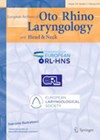
Journal Reviews
Chronic rhinosinusitis update
There is still a lack of awareness of chronic rhinosinusitis (CRS) despite its burden, calling for events such as the recent Global Chronic Rhinosinusitis with Nasal Polyps (CRSwNP) Awareness Day. Research findings from recent publications by Backaert et al have...
A useful adjuvant treatment for SNAC or IP
5-Fluorouracil (5FU) is a topical preparation used in the treatment of various dermatological, ocular and gynaecologic malignant and pre-malignant conditions, and this literature review looks at the efficacy of 5FU in treating inverted papilloma and sinonasal tumours. The authors cite...
Intra orbital treatment to save the eye!
Invasive fungal sinusitis can be a devastating condition, and accepted management is surgical debridement of infected tissue, systemic antifungal treatment and reversal of immunosuppression. Orbital involvement is common, affecting up to 75% of cases, and in advanced disease orbital exenteration...
Tubomanometry in eustachian tube dysfunction
This prospective study evaluated the validity and reliability of tubomanometry (TMM) in 25 patients with sinus disease, 75 patients with middle ear disease and 25 healthy volunteers. After thorough clinical examination, the participants were evaluated with TMM, nasal endoscope, otoendoscope,...
A viable solution for isolated post-nasal drip?
This retrospective, single-centre case series looked at a cohort of patients with postnasal drip as their primary symptom. Exclusions were patients with chronic rhinosinusitis. The interventions offered were temperature-controlled radio frequency (TCRF) ablation of the posterior nasal nerve delivered by...
Factor favouring the need for revision FESS in chronic sinusitis with polyps – a multivariate analysis including phenotypes
Chronic rhinosinusitis with polyposis is a type 2 inflammation with risks of recurrence and need for revision operations. This is known to depend on the endotype and phenotype factors. This is a retrospective study of 212 patients. Of these, 112...
Early DCR may be better than delayed in acute dacrocystitis?
Traditionally, acute dacrocystitis has been treated conservatively with antibiotics, analgesia and warm compresses, with surgery reserved for later when the infection has subsided. This meta-analysis looks at early vs. late endonasal dacrocystorhinostomy (DCR) in the treatment of acute dacrocystitis, looking...
Nasal allergies and OSA
The first day of June is the meteorological start of summer. As a moderately wet spring slowly blurs to (a damp UK) summer, we can look forward to holidays in the countryside, enjoying the changing pollen seasons from tree to...
Rosemary oil to aid surgical healing?
There are a multitude of ways in which to damage the nasal epithelium, whether iatrogenically through nasal surgery, via injury, allergy, infection or inhalation of an environmental pollutant. This study looks at the role of the herb rosemary, in the...
Neonatal nasal stenosis - conservative approach
The authors retrospectively evaluated the efficacy of heated humidified high-flow nasal cannula (HFNC) in neonates with nasal stenosis for this study. Of the six infants included in the study, five had congenital pyriform aperture stenosis. Three of these five also...
A comparison between biologic and surgical treatment (FESS) for chronic rhinosinusitis with polyposis
In recent years, it is being increasingly recognised that chronic rhinosinusitis with nasal polyps (CRSwP) is a type 2 chronic inflammation based on IL-4 and IL-13, and the novel monoclonal antibody, such as dupilumab, is likely to have a major...
An effective treatment for post Covid-19 smell loss?
It is well understood that calcium levels in the nasal mucous affect the ability to smell, with higher levels having a negative impact, and some studies have shown increased calcium levels in patients suffering with Covid-19-related olfactory dysfunction. Calcium chelating...















